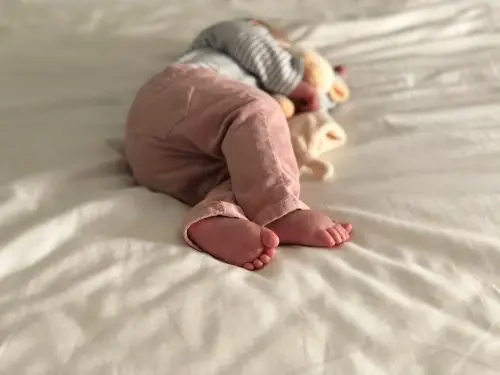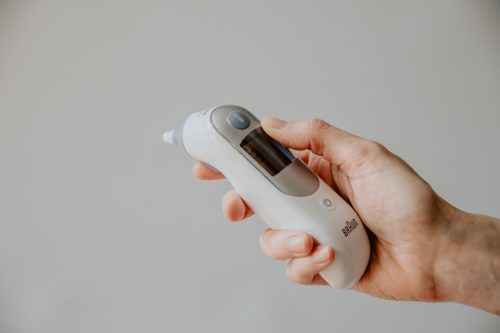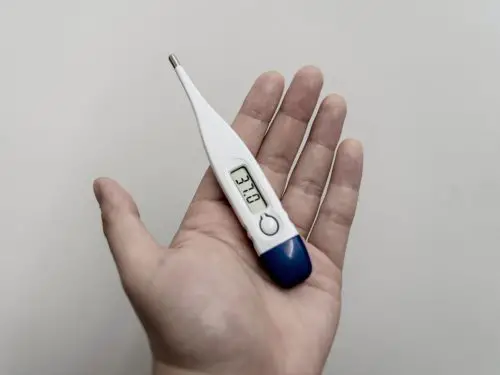Wondering how to tell if baby has fever without thermometer? It’s possible! Although having a thermometer handy is certainly best practice when it comes to diagnosing fever in babies, it isn’t the only way to tell if your baby is ill. Many signs can point to sickness in a child including how they look, feel, and how they behave. Taking all of this into account will help you determine if your baby has a fever. It can help you make a decision about what the next best course of action may be.
Join us as we delve into the various ways you can determine if your baby has a fever without the use of a thermometer.
How to Tell If Baby Has Fever Without Thermometer
How Can I Check My Baby’s Temperature Without a Thermometer?
Generally speaking, it is still possible to assess whether or not your baby has a fever without a thermometer, however, you won’t get an actual numerical reading. As such, you won’t be sure whether or not your baby has a high fever temperature –which warrants a visit to the hospital – or a low one.
Still, knowing whether or not your baby is running a temperature can be helpful, especially if your baby isn’t looking or acting the way that he or she normally does.

Measuring Fever Without Thermometer
How to Take Temperature Without Thermometer
To take your baby’s fever without a thermometer, you’ll want to use your hands.
It is best practice to ensure that your hands are clean and are at a neutral temperature, as hands that are too hot or cold may startle your baby and also give you an inaccurate measurement of your child’s body temperature.
Once you’ve got your hands clean and at a neutral temperature, use the back of your hands to gently feel your baby’s forehead. When you do this, you are checking to see if the skin feels hot to the touch.
When your baby is running a fever, the skin will feel particularly hot. The same is true for your baby’s cheeks. Carefully use the back of your hands to check the temperature of your baby’s cheeks.
Other clues of fever that can be assessed by using your hands include whether or not your baby’s skin feels damp or excessively sweaty.

How Do I Know If My Baby Has a Fever?
Signs of a Fever Without a Thermometer
If you find that your baby does feel abnormally hot, it may be time to check him or her for other signs of fever and illness.
Though the following isn’t an exhaustive list, these additional signs of fever in babies can help confirm abnormalities in temperature that you felt with your hands:
- Flushed Skin: If you happen to notice that your baby’s cheeks or other areas of their face and body appear as a rosy red, take notice. These can be signs that your baby is poorly or sick, especially if your baby feels hot to the touch. On the flip side, if your baby isn’t feeling hot or isn’t displaying other concerning symptoms, then there may be perfectly normal explanations for why your baby’s cheeks are flushed. Other reasons for flushed cheeks include excitement, anger, and hot weather.
- Sweating: Do you notice that your baby is sweating even when he or she isn’t in hot weather? This is another concerning sign of fever in babies and can occur in tandem with flushed skin.
- Foul Mood: Is your baby particularly fussy, clingy, or unable to be appeased even by his or her favorite toys, snacks, and games? These are strong indicators that your child is feeling under the weather. Be sure to pair this symptom with some of the others mentioned, though; a foul mood can also be linked to causes not directly related to illness.
- Abnormalities in Routine Behavior: Is your baby acting differently at certain times of the day or in situations in which they normally would not? If your baby starts crying when they see their favorite stuffed dog or whines when you sit them down to play then these are also indicators that your baby may be sick.
- Interrupted Sleep: Though moms and dads alike love long stretches of uninterrupted sleep at night, the truth is that when your baby is feeling ill, this may not happen. If you notice that your baby is waking frequently in the middle of the night, it may be because he or she is experiencing symptoms that are making it difficult for them to sleep. Assess your baby using the methods above if he or she is frequently waking to determine if he or she has a fever. Also, despite the many benefits of sleep training, you’ll want to forgo that if your baby falls ill. Never neglect or leave your sick baby alone to cry. You can always retrain your baby when he or she feels better.
- Shivering: Sometimes, fevers can bring on shivering in babies and adults. It can be accompanied by blue lips as well, but not always. If you notice this, it is a strong sign that your baby may have a fever. Moreover, if you notice that your baby has blue lips and the environment isn’t cold, you will want to see a doctor right away.
- Common Cold Symptoms: Lastly, be sure to watch out for typical cold symptoms such as a runny nose, sore throat, congestion, headache, or cough. A common cold is not always accompanied by a fever, but sometimes it can be. Cold symptoms paired with hot skin are often definite indicators of a baby running a temperature.
How to Check Baby Fever Without Thermometer
Remember that the best way to check baby fever without a thermometer is to use your hands. In addition to checking your baby’s forehead and cheeks, you may also gently feel your baby’s back and tummy using the back of your hands to assess for warmth. If the back, tummy, head, or cheeks feel hot, it may be that your baby has a temperature.

How to Know If You Have a Fever Without a Thermometer
Without a thermometer, it can be difficult to say definitely whether or not your baby has a fever. Look for the following signs of fever without a thermometer:
- Red Cheeks
- Damp Skin
- Profuse Sweating
- Irritability
- Abnormal Behavior
- Over-Sleeping
- Under-Sleeping
- Puffy Eyes
- Shivering
- Runny Nose
- Sore Throat
- Headache
- Congestion
How to Take a Baby’s Temperature
The following are the most common ways to take your baby’s temperature using a thermometer. Though there are many different kinds of thermometers available, you will find some to be better than others depending on your child’s age. Consult with your doctor to help determine the best method of taking your child’s temperature.
Rectal Temperature-Taking and How-To
A rectal thermometer is one that is specifically designed to go in the rectum. Though it may seem uncomfortable for your baby, it is actually the recommended way to take a temperature for newborns that are three months and younger.
The following is how to take your baby’s temperature with a rectal thermometer:
- Place your baby on a firm, secure and safe surface.
- Lay your baby on his or her side.
- Firmly grip your baby to hold him or her still. Be sure that your baby is still comfortable.
- Insert the rectal thermometer only by half an inch. Never stick the thermometer in any further than this.
- Keep the thermometer in the rectum until a reading is received.
- Clean the thermometer and keep it separate from oral thermometers.
Tympanic (Ear) Temperature-Taking and How-To
Taking a temperature via ear is typically done using infra-red sensors similar to a temporal artery thermometer. As such, this way of temperature taking isn’t always as accurate as other ways. But it is still a viable and more comfortable way of taking a temperature than other methods.
To take a temperature using a tympanic thermometer you should:
- Ensure that your thermometer is designed to take ear temperature readings. Do not use any other type of thermometer for a tympanic reading.
- Ensure the thermometer is clean and ready for use.
- Gently pull back and tug up on your child’s ear for better access to their ear canal.
- Carefully insert the thermometer in the ear canal.
- Push the designated button to take the temperature for approximately one second.
- Check the temperate reading.
Note: Always follow the specific instructions given by your tympanic thermometer when attempting to get an accurate reading of your child’s temperature.

Underarm Temperature-Taking and How-To
Taking a temperature under the arm is the second most recommended method for taking the temperature of young babies. It can be done with a standard thermometer, as long as the thermometer isn’t labeled for specific use in the rectum, on the forehead, or in the ear.
To take an underarm temperature, do the following:
- Ensure the thermometer is clean.
- Shake the thermometer until the mercury is below 96.8 degrees Fahrenheit.
- Gently lift your baby’s arm and place the thermometer underneath the armpit.
- Lower your child’s arm and gently hold his or her arm in place.
- Continue in this position until the thermometer beeps or until it has been at least 4 minutes.

Oral Temperature-Taking and How-To
Taking a temperature orally is a very common practice. But because it involves maneuvering the tongue, it is not suggested until your child is at least four years old.
If your child is four years or older, follow these steps to take your child’s temperature through the mouth with an oral thermometer:
- Clean the thermometer or place a thermometer cover over the tip
- Shake the thermometer until the mercury level reaches a temperature below 96.8 degrees Fahrenheit.
- Instruct your child to lift his or her tongue.
- Place the thermometer beneath the tongue.
- Keeping the thermometer beneath the tongue, instruct your child to lower his or her tongue and to close his or her mouth.
- Wait 40 seconds or until you hear a beep, whichever comes first.
- Analyze the reading.
Temporal Artery Temperature-Taking and How-To
Temporal artery temperature taking has grown in popularity recently. This is especially given its unique ability to be used while the baby is sleeping. It is also a fairly accurate way to measure your baby’s temperature. Although there are environments and other factors that can skew the readings at times.
If you want to use an infrared temporal artery thermometer, follow these steps:
- Turn the device on.
- Align the project red dots to the center of your baby’s forehead.
- Press the designated button to take the temperature.
- Read the temperature on the digital display.
Fever in Babies: When to Worry
When Should I Worry That My Baby Has a Fever?
If your baby is displaying signs of a fever, or if you have taken your baby’s reading using an actual thermometer, then you may or may not need to bring your little one in for medical care.
Medical care for babies with temperatures is not always necessary, but sometimes, a fever can be a sign of an underlying condition that shouldn’t be ignored.
In general, a baby with a fever of any sort that is younger than three months should be seen by a healthcare professional right away.
For babies older than three months, a temperature of 102 degrees Fahrenheit and over also warrants a visit to the hospital.
Other signs that your baby should see a doctor include:
- A fever that has lasted longer than 5 days
- Fever higher than 104 degrees Fahrenheit
- A fever that doesn’t respond to fever reducers (Note: Only use fever reducers when age-appropriate–Refer to the box instructions for proper age recommendations, or consult a pediatrician)
- Your baby is having difficulty taking liquids
- The child isn’t easily roused when sleeping
- Your baby isn’t acting normally
- Your baby was immunized within 48 hours of the fever
If you are uncertain about whether or not your baby should be seen by a doctor, your best bet is to either call the hospital for advice or simply bring your child in to be assessed in person.

How to Bring Down a Fever in a Baby
How Do I Lower My Baby’s Temperature Safely?
If you do find that your baby has developed a temperature, you may want to see what you can do to lower it.
But before you do, it is important to understand that a fever is your baby’s body’s way of fighting infection. Thus, in many ways, a fever isn’t always bad, though it may be uncomfortable for your child.
On the other hand, if your baby’s temperature gets too high, it could be harmful to your baby’s health. As such, it is helpful to know how to bring down a fever in your baby.
To properly bring down a temperature in your baby, you may consider giving your baby a lukewarm bath, applying a cold compress to their forehead, and dressing them in removable layers of clothing for easy adjustment.
Remember that if your baby seems cold and is shivering, it is best to dress your baby in layered clothing. However, if your baby is flushed and visibly seems hot, you should consider dressing him or her in lightweight breathable material such as cotton materials.
Whatever you do, avoid fever reducers, especially in young infants. Many fever reducers aren’t safe for children younger than 2.
FAQ
Temperature readings can vary depending on the type of thermometer you use. Nevertheless, you will need to watch for readings that are very high as this could warrant a visit to the hospital.
Use the table below to determine whether or not you should be concerned about your baby’s temperature in relation to their age.
| Age | What Is Considered a High Fever |
| Newborn (0-3 months) | 100.4° F or Higher |
| 3 months to 3 Years | 102° F or Higher |
| 3 Years or Older | 104° F or Higher |
How to Tell If a Baby Has Fever Without Thermometer Is Relatively Simple
Having the ability to tell whether or not your baby is running a fever without the use of a thermometer is a good skill to have. You never know when there could be a situation in which you are left to figure out if your baby is ill without a thermometer. Thus, if you were ever wondering when to start buying baby things, especially important ones such as a thermometer, the answer is as soon as possible, for this very reason.
Remember that when taking your baby’s temperature without a thermometer, you should use the back of your hand on your baby’s forehead, tummy, cheek, or back. Moreover, look for signs and symptoms that your baby isn’t feeling well. Is he or she grouchier than normal? Are there other signs of illness such as flushed skin, a runny nose, or puffy eyes? All of these factors are important to consider when you are determining whether or not your baby has a fever.
If at all possible, do take your baby’s temperature the correct way using one of the thermometers we described in the above post. Also, be sure to contact your local hospital right away if your baby is running a high temperature for his or her age in accordance with the aforementioned guidelines.
If you have further questions about the health status of your baby, be sure to contact and follow the advice of a trusted local healthcare professional.
Lynn
Lynn is a freelance writer, a wife, and a mother of two beautiful kids. Lynn started Infant Empire with the aim of making parenting easier for fellow mums and dads. She believes the parenting tips provided here will be of great help to all parents.Recommended Reading
Baby Scratching Back of Head: What Does It Mean and What Should I Do When My Baby’s Head Itches?
Join us as we delve into the various reasons for your baby scratching the back of their head, and what, if anything, you can do about it.
Best Fetal Doppler for early pregnancy
One major cause of anxiety among mothers to be is not feeling the baby kick as often as they are used to. A few years ago, the only way to ease this anxiety was to have the fetal heart rate checked in the OB’s office as soon as possible
Baby Hair Color Change: What Age Does Baby’s Hair Color Change?
In this post, we will explore the question of, “what age does baby hair color change” as well as why these changes happen.
Cut Baby Hair Before 1 Year: Can I Do It and Should I Do it?
You may be considering to cut baby hair before 1 year old age. But should you do so? Let's discuss whether or not it's wise in this post.
Baby Cold Hands While Sleeping: What Should Baby Wear to Sleep
All in all, if your baby has cold hands and feet, it could be an indicator that he or she is chilly but not always.
Best Swaddle and Sleep sack for 3 to 6 month old (2022)
Choosing best swaddle for 3 month old baby may be challenging because babies at this stage want to explore mostly using their hands.